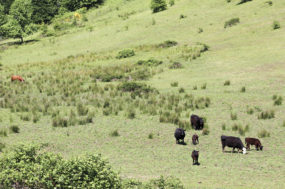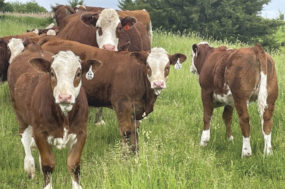This resulted in two full weeks of extremely light on-site auction movement to start the month; however, every major video auction held significant sales, offering nearly 650,000 head of late-summer and fall delivery cattle. Contract prices were well established with heavy yearling steers (850 to 950 pounds) mostly yielding $105 to $110 per cwt and lighter weight fall steer calves (500 to 600 pounds) predominantly selling from $120 to $130 per cwt with prices improving into winter delivery.
 Beef markets are usually lackluster during the dog days of summer, but this year mid-summer finished cattle prices were mostly $10 per cwt higher than last year and boxed beef cut-out values ranged around $15 per cwt higher than 2009. Feeder cattle markets are also $10 to $15 per cwt higher than last summer with no real signs of weakening. For the month, calves and yearlings sold $1 to $3 per cwt higher in the Southern Plains and $2 to $5 higher in the Southeastern calf markets and the Northern Plains, where independent farmer-feeders were more aggressive than in recent years, with many holding damaged corn from the late harvest that won’t pass inspection and must be fed.
Beef markets are usually lackluster during the dog days of summer, but this year mid-summer finished cattle prices were mostly $10 per cwt higher than last year and boxed beef cut-out values ranged around $15 per cwt higher than 2009. Feeder cattle markets are also $10 to $15 per cwt higher than last summer with no real signs of weakening. For the month, calves and yearlings sold $1 to $3 per cwt higher in the Southern Plains and $2 to $5 higher in the Southeastern calf markets and the Northern Plains, where independent farmer-feeders were more aggressive than in recent years, with many holding damaged corn from the late harvest that won’t pass inspection and must be fed.
Calf movement is usually light during July as America’s cow herd is heavily unbalanced to the spring calving side, but this year lightweight sales were even more limited as most fall-born calf raisers took advantage of the lofty spring prices right off the cow. Backgrounders who purchase calves and grow them through their middle weights are already fearing what price levels for next spring’s lightweight calves will be, as herd reduction continues at a fast pace.
Cow/calf producers failed to rebuild their numbers according to normal cyclical trends a few years back and this year’s culling has been even deeper with record-high slaughter cow and bull prices. Through the first six months of 2010, domestic beef cow slaughter was 13.2 percent more than 2009 and a whopping 18 percent more than the five-year average. The average age of our cow/calf producer is nearing retirement and inflated land values are hard to support in the age of urban sprawl, conservation and corporate farming. Plus, technology continues to allow more bushels to the acre, but seems to never aid in less acres to the cow.
Late July saw a heavy movement of yearlings of double-stocked pastures in the Flint Hills and Osage grazing regions. Yearling sellers in other parts of the country also pulled their cattle off lush grass to take advantage of the handsome price levels. Every year, backgrounders seem to market their yearlings a bit earlier to beat the heavy supplies of calves that always pressure the market when the leaves start to fall. Commercial feedyards and farmer-feeders readily absorbed these feedlot replacements as their condition is “green” right off grass and performance is usually outstanding during the moderate autumn months. Weights of yearlings off grass have been at least adequate as very few spots in the major cattle production areas are suffering from dry weather, although some are too wet and the grass has been a little washy.
Cattle feeders enjoyed an unusually satisfying mid-summer rally in fed cattle prices in July. The direct slaughter steer and heifer market gained near $4 per cwt (to mostly $95 per cwt) as market-ready supplies are tight and feedlot managers have marketed aggressively and are currently showing cattle nearly a month ahead of schedule. ![]()








